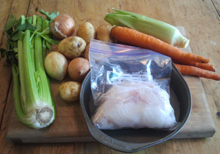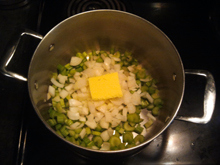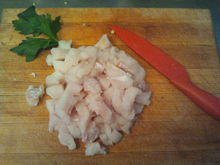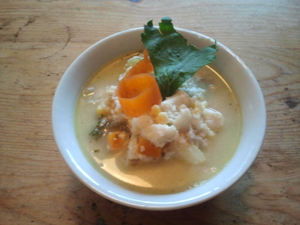So there I was on a cloudy Sunday afternoon, the weight of another blog deadline bearing down on me like the crashing Atlantic waves in hurricane season. I had a mixed variety of seasonal veggies from the Seaport Farmers’ Market pressing against the seams of my fridge (potatoes, carrots, celery, corn, onions, garlic).
I also had my weekly fish share from Off the Hook. And yet with all of these options, I couldn’t for the life of me conjure up a meal idea. The question pounded in my egg shaped head “What am I going to make?.. Dear god, what am I going to I make?”
I pulled all of the vegetables out of the fridge and placed them on the table in a U shape around a frozen Ziploc bag of cod. I focused on the cod for so long that it almost seemed to be glaring back at me. “Whattya gonna you do with me boy?” it taunted. The frozen bag of fish and I remained locked in perpetual stand-off. Neither of us budged for what seemed like an eternity, until finally it hit me. It was as though the cod had somehow re-animated, leapt from the table and slapped me in the face with its once present tail! There it was!
CHOWDER! COD CHOWDER!!!
Given my ongoing efforts to integrate into Nova Scotia society, by way of their cuisine, chowder seemed like an excellent choice. To understand a culture, one must understand where it comes from, and what it ate along the way. So I delved into the culinary history of this foundational fish feast. Some believe the term comes from the French word chauderée meaning pot or cauldron. While others speculate it is derived from the Old English word jowter or fish peddler (See link). I’d say the marriage of the two words seems most likely, as Bretons and Acadians collided on the salty shores of the eastern seaboard.
Regardless of its linguistic origins, chowder has been a staple for peasants, paupers, muckers and mongers on the coast for hundreds of years. It’s said that fisherman on the coast would throw portions of their catch, along with other perishable items into a pot, to make a thick stew to carry them through their long days at sea. It was the original ‘clean out the fridge meal’ well before the fridge was ever invented. Having the chance to whip up a batch made me feel as though I was slurping up the rich, creamy soup that is the Atlantic’s working class history.
Ingredients:
1.5lbs of cod fish.
4 tbsp or so of butter.
2 onions chopped.
2 cups potatoes, diced and peeled.
1 cup carrots diced.
1 cup celery diced.
1 cup corn.
2 cups water
1.5 cups milk (creamier the better)
2 tbsp parmesan
Dried thyme, savoury, or substitute.
Salt and pepper to taste.
How She’s Done:
Chop and dice your vegetables, adding first your onions, garlic and celery to pot with butter and salt. Allow them to cook until translucent, and then begin to add your more hearty vegetables; potatoes, carrots, etc.
As those vegetables simmer, dice cod into bite sized pieces, and add them to the chauderée. Slowly add portions of milk/cream and water to the mixture. Be careful not to drown the soup immediately. Allow it to cook in layers, adding more liquid as required.
At this point sprigs of thyme or savoury can be added to flavour the broth. I also added the first of many rounds of parmesan at this point. Some recipes suggested bacon..yum. Then simply cook the soup for 20-30 mins, allowing the flavours to intermingle. The soup is best if allowed to cool, and then reheated. However at this point it’s ready to serve if you or your shipmates are starving.
And there it is, a truly historic dish!








